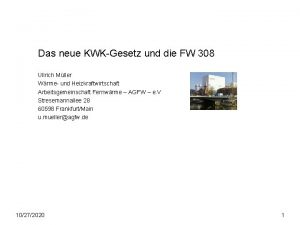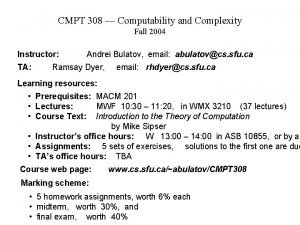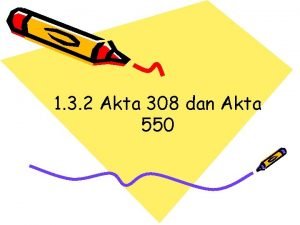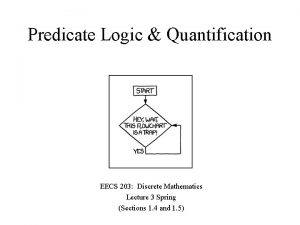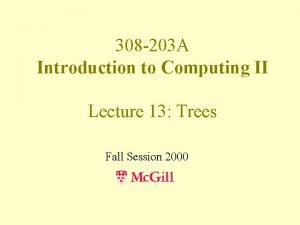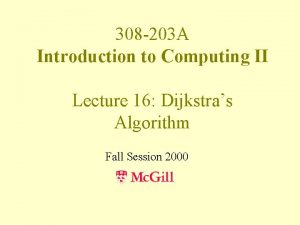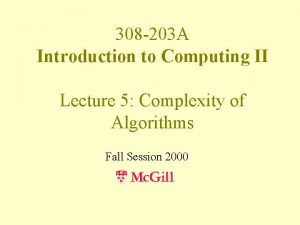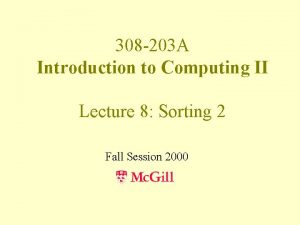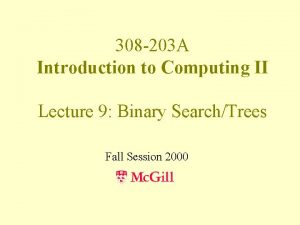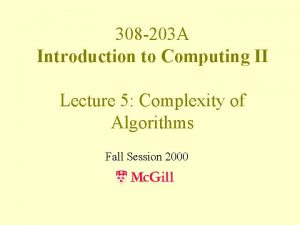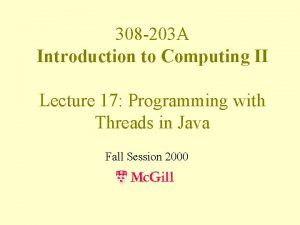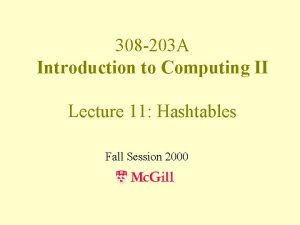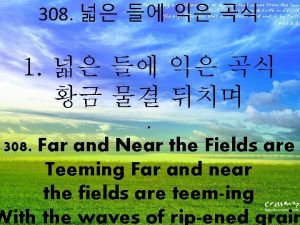308 203 A Introduction to Computing II Lecture



![Running Time of DFS Total Time = v V [ Tv ] [ degree(v) Running Time of DFS Total Time = v V [ Tv ] [ degree(v)](https://slidetodoc.com/presentation_image_h2/68595f089db7e291ad8e343299856324/image-4.jpg)















- Slides: 19

308 -203 A Introduction to Computing II Lecture 15: Searching Graphs II Fall Session 2000

Depth-First Search (Assume all nodes start off colored white) DFS-Visit(Vertex v) { v. set. Color(grey); for each u in v. neighbors() if (u. color( ) == white) DFS-Visit(u); v. set. Color(black); }

Running Time of DFS For a connected graph G= (V, E), DFS-Visit will be called exactly once per vertex. When called for a vertex v V, the time taken is: Tv = time for the “for” loop + constants = ( degree(v) ) + (1)
![Running Time of DFS Total Time v V Tv degreev Running Time of DFS Total Time = v V [ Tv ] [ degree(v)](https://slidetodoc.com/presentation_image_h2/68595f089db7e291ad8e343299856324/image-4.jpg)
Running Time of DFS Total Time = v V [ Tv ] [ degree(v) + 1 ] = v V degree(v) + = O( |E| + |V| ) v V 1

Deficiencies of DFS explores a single path until it hits a cycle and then backtracks… this was observed to be stupid for some examples, like graphs representing games. What if we take the other extreme and always fully explore the nth step before considering possible steps for (n+1)?

Breadth-First Search (BFS) • Maintain a queue of vertices to explore • Service the queue by exploring that vertex • When exploring a vertex, queue up any unexplored neighbors

Breadth-First Search Again, assume all vertices start of “white” BFS( Vertex start. Vertex ) { start. Vertex. set. Color(grey); queue. enqueue( start. Vertex ); while (queue. has. More. Elements( )) { Vertex v = queue. dequeue( ); explore( v ); } }

Breadth-First Search explore( Vertex v ) { forall u Neighbors( v ) if (u. color() == white) { u. set. Color( grey ) ; queue. enqueue( u ); } v. set. Color( black ); }

BFS - Example Start by enqueueing “a” a b d e Queue = { a } c f

BFS - Example Service “a” by calling explore( ) a b d e Queue = { b, d } c f

BFS - Example Service “b” (“d ” remains in the queue) a b d e Queue = { d, e } c f

BFS - Example Service “d”: no unexplored neighbors a b d e Queue = { e } c f

BFS - Example Service “e”: enqueues “c” and “f” a b d e Queue = { c, f } c f

BFS - Example Service “c”: no unexplored neighbors a b d e Queue = {f } c f

BFS - Example Service “f”: now the queue is empty a b d e Queue = c f

BFS and trees • Like DFS this can be thought of as inducing a tree (with edges from any node u to each other node v which it enqueues)

Comparison to DFS a b d e c DFS f Visited: (a, b, e, d, [e], c, f, [c], [e], [b], [a]) a b c BFS d e Visited: ( a, b, d, e, c, f ) f

Running time of BFS? Same as for DFS: for exactly the same reason! • Every node gets enqueued, and therefore explored exactly once • In explore, there is a loop over all adjacent vertices, giving the same O( degree(v) ) term O( |V| + |E| )

Any questions?
 01:640:244 lecture notes - lecture 15: plat, idah, farad
01:640:244 lecture notes - lecture 15: plat, idah, farad Parallel and distributed computing lecture notes
Parallel and distributed computing lecture notes Cmu cloud computing
Cmu cloud computing Conventional computing and intelligent computing
Conventional computing and intelligent computing The present progressive tense (p. 308)
The present progressive tense (p. 308) Ap308 dan ap 309
Ap308 dan ap 309 Fw 308
Fw 308 Bot 308
Bot 308 Cmpt 308
Cmpt 308 Akta 550 pendidikan awal kanak-kanak
Akta 550 pendidikan awal kanak-kanak 6-sinf ona tili 329-mashq
6-sinf ona tili 329-mashq Bot 308
Bot 308 Arc 308
Arc 308 308
308 Software engineering
Software engineering Kudu shot placement
Kudu shot placement 2cfr200.308
2cfr200.308 Nactrc
Nactrc Eecs 203
Eecs 203 Fha 203 h loan
Fha 203 h loan






